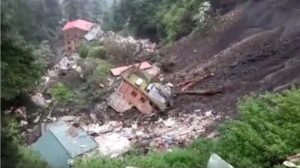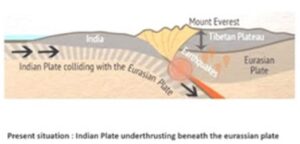Resisting Landslides.
Relevance
- GS Paper 3 Disaster and disaster management.
- Conservation, environmental pollution and degradation, environmental impact assessment.
- Tags: #upsc #Himalayas #Himalayanlandslides #landslides #IE
Why in the News?
The recent incidents of deaths and destruction due to landslides in Himachal Pradesh have focused attention on the fragile Himalayan ecosystem.
Fragile Himalayan Ecosystem: Understanding the Challenges
The Complex Himalayan Ecosystem
- The recent devastating landslides in Himachal Pradesh have highlighted the fragility of the Himalayan ecosystem, the world’s youngest and most rugged mountain range.
- This ecosystem is shaped by tectonic and neo-tectonic activities, subsurface processes like rock deformation, and surface processes such as erosion, weathering, and precipitation.
- These factors create an inherently fragile environment prone to events like avalanches, landslides, debris flows, glacial lake outburst floods, and flash floods, exacerbated by climate-induced events like freezing/thawing and heavy rain/snow precipitation. Anthropogenic activities further stress the ecosystem.
Building Resilience: Addressing Geo-Hazards
The Need for Resilience
- To cope with the challenges posed by natural processes, environmental degradation, and human activities, building resilience against geo-hazards becomes crucial. Implementing a comprehensive strategy involving various measures is imperative.
Integrated Early Warning System
- Developing an integrated Early Warning System (EWS) is paramount. This system should involve a network of sensors, real-time monitoring, data analysis, and integration. Leveraging AI/ML algorithms can enhance the efficiency and accuracy of the EWS, ensuring timely alerts about impending geo-hazard events.
Climate Change Impact: Vulnerabilities Amplified
Impact on Vulnerability
- Climate change exacerbates vulnerabilities in glaciers, riverine systems, geomorphology, and biodiversity, ultimately affecting the people in mountainous regions. Land degradation further compounds the problem, creating a perilous situation.
Understanding Landslide Dynamics: Stress and Triggers
Subsurface Stresses and Landslides
- The convergence of the Indian plate with the Eurasian plate in the Himalayan region generates subterranean stresses that manifest as earthquakes.
- These earthquakes cause fractures and loosen litho-structures near the mountain surface, increasing the risk of rock movement and landslides.
Rainfall Threshold and Warning Systems
- Effective landslide warning systems should be rooted in an understanding of the rainfall threshold for different slopes.
- Monitoring and predicting landslides should involve considering the critical amount of rainfall that triggers instability.
Mitigating Factors: Managing Vulnerabilities
Slope Instability and Vulnerabilities
- Various factors contribute to slope instability and vulnerability to landslides, including slope gradient, elevation, rock strength, forest cover, and sediment type.
- Human activities like deforestation and alteration of riverine flow further elevate the risk.
Balancing Development and Sustainability: Future Steps
Harnessing Resources and Sustainable Development
- The region’s abundant resources, including glaciers, energy sources, and biodiversity, offer opportunities for sustainable socioeconomic development. However, striking a balance between resource exploitation and ecological sustainability is crucial.
- Careful town planning is needed, emphasizing proper drainage systems, retaining walls, and adherence to building codes to minimize the risk of landslides and other hazards.
Towards Collaborative Action: The Role of a Himalayan states together
Coordinated Efforts for a Safer Himalaya
- A Council of Himalayan States should be established to foster collaboration among states facing similar challenges.
- Sharing knowledge and assessments can aid in developing effective strategies, addressing vulnerabilities, and ensuring the safety of the region’s inhabitants.
- By addressing these multifaceted challenges and adopting proactive measures, we can enhance the resilience of the Himalayan ecosystem and better prepare for the inevitable geo-hazard events.
The writer underscores the urgency of building resilience against geo-hazards in the Himalayas. By understanding the region’s vulnerabilities, implementing advanced monitoring systems, and fostering collaboration among Himalayan states, we can effectively mitigate the impacts of landslides and other natural hazards.
| National Disaster Management Authority
The National Disaster Management Authority (NDMA), established under the ambit of the Disaster Management Act, 2005, stands as a statutory and supreme body led by the Prime Minister. Its principal responsibility is to formulate comprehensive policies, plans, and guidelines for effective disaster management, ensuring swift and efficient responses to unforeseen catastrophes. National Landslide Risk Management Strategy In a pioneering stride, the formulation of a National Landslide Risk Management Strategy has been undertaken by a dedicated Task Force composed of experts. This Task Force stands divided into six distinct Sub-Groups, each adeptly addressing various facets of landslide disaster risk reduction: · Sub-Group I: Generation of User-Friendly Landslide Hazard Maps. · Sub-Group II: Development of Landslide Monitoring and Early Warning System. · Sub-Group III: Awareness Programmes. · Sub-Group IV: Capacity Building and Training of Stakeholders. · Sub-Group V: Preparation of Mountain Zone Regulations & Policies. · Sub-Group VI: Stabilization and Mitigation of Landslides and Creation of Special Purpose Vehicle (SPV) for Landslide Management. |
Sources: Indian Express
Mains Question
Discuss the geological factors contributing to the vulnerability of the Himalayan region to landslides and other geo-hazard events. How can early warning systems based on modern technology help mitigate these risks? 250words.





